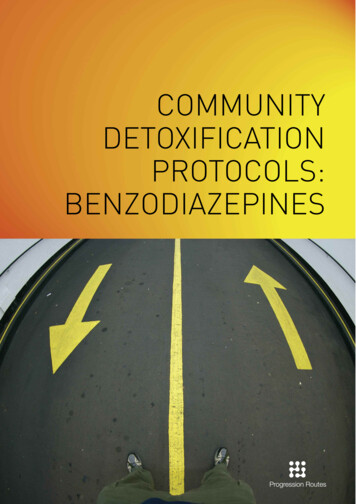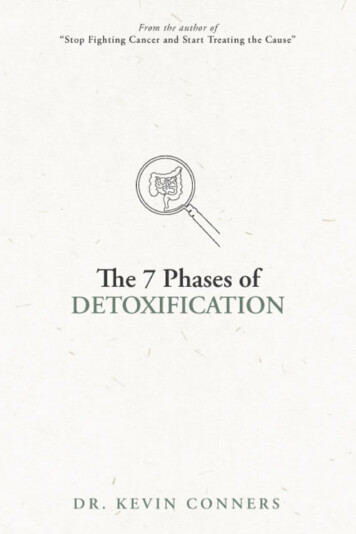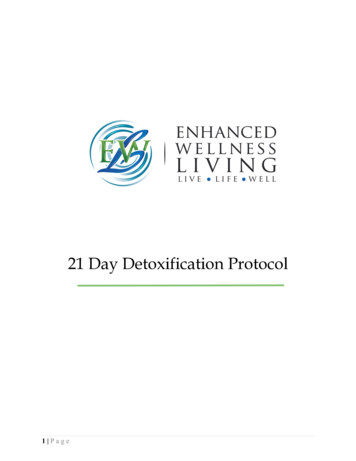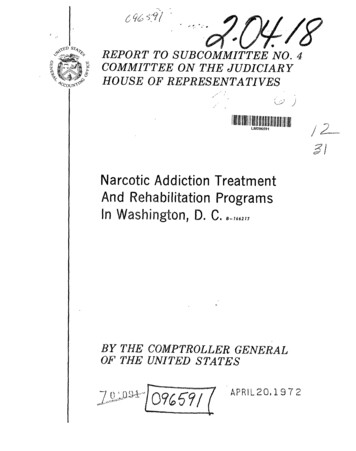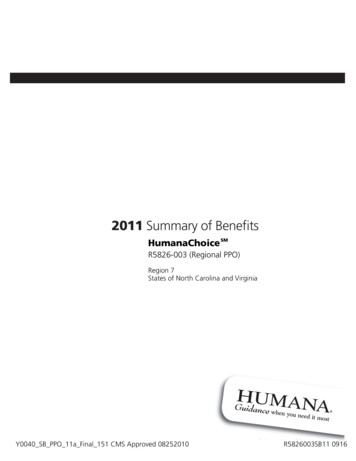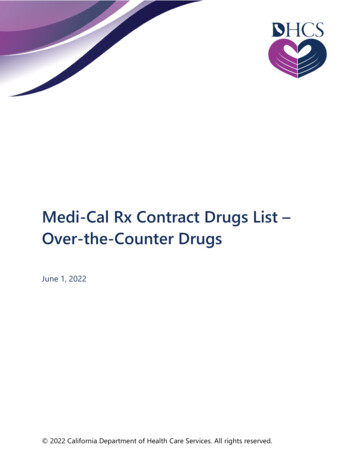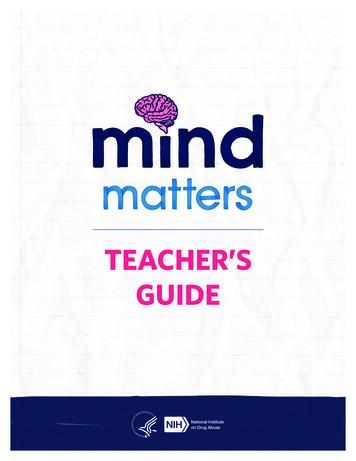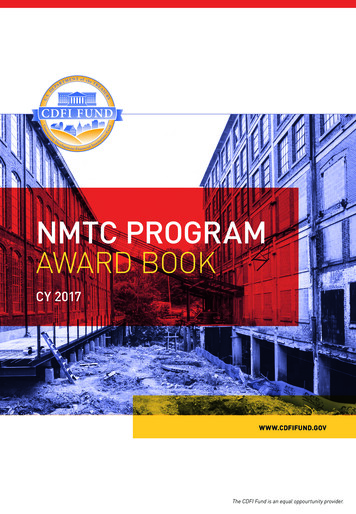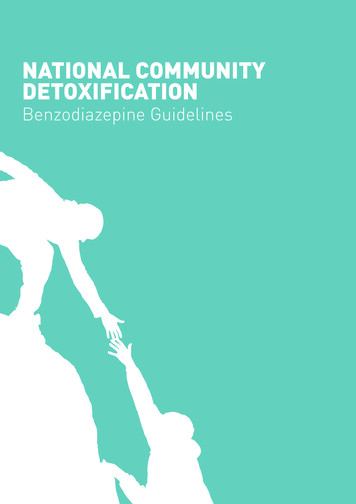
Transcription
NATIONAL COMMUNITYDETOXIFICATIONBenzodiazepine Guidelines
2016 Ana Liffey Drug Project
Table of Contents1 Introduction1.1 4.5.24.666What is Community Detoxification?Community Detoxification Steering CommitteeProfessional liabilityUses and limitations of these guidelinesA step towards residential detoxificationCommunity-based servicesHistory and rationale for the Community Detoxification ProtocolsNorth Inner City Drugs Task Force Community Detox EvaluationNational PilotUpdated guidelinesChanges in these guidelinesThe Ana Liffey Drug ProjectGuideline structureSummary888999910101010111111Delivering Community DetoxificationPsychosocial supportMedical supportProfessional relationshipsUnder 18s1414141415Community Detoxification StepsEstablishing a key work relationshipKey work preparation for GP assessmentGP assessmentMedical contraindications to Community DetoxificationCommunity Detoxification and pregnancyOther factorsDual addictionPoly drug useMental healthThe choice of setting17171718181819192121225 Psychosocial support66.16.26.36.425Key work processPreparing for the GP assessmentPreparing for detoxificationPsychosocial supportPsychosocial support during aftercare7 Medical support2727282929328 Medical support process8.1 GP assessment8.2 tDefinition of disengagementOutcomes of disengagementRe-engagement/requests for a second detoxification3
itionBenzodiazepine detoxificationBefore benzodiazepine detoxificationEntry requirementsRisks during and after detoxificationAreas to plan for during and after detoxificationExit points and entry dules, conversion table and detoxificationDetoxification guidelines for GPsSchedulesConversion tableBenzodiazepine withdrawal symptoms4444444546References48Appendix 1Initial meeting forms 50Appendix 2Service User Risk Information and Agreement 51Appendix 3Key Work Assessment Form 53Appendix 4Treatment Outcomes Profile (TOP)for Community Detoxification57 4
5
1. IntroductionThese guidelines were developed from the Community Detoxification Protocols (AnaLiffey Drug Project, 2011) which were reviewed and amended in 2015. The purposeof these guidelines is to advise on the detoxification of service users in a communitysetting. The recommendations contained in these guidelines were developed by anexpert multi-disciplinary team from within the addiction sector while also taking intoconsideration the available literature. This document provides support for the treatmentof service users who are undergoing detoxification for benzodiazepine dependence.These guidelines are intended to be read by those involved in providing psychosocialand medical support for detoxification in a non-residential treatment setting. Theseguidelines outline the minimum medical and psychosocial supports which should beprovided to an individual engaging in Community Detoxification.1.1 AimsThese guidelines aim to: reduce variation in practice and improve the quality of treatment decisions; provide professionals with structure and support to improve treatment outcomes; ensure that community-based detoxes have a medical and psychosocial supportstructure; educate health care professionals on the accessibility of community baseddetoxification; deliver a convenient treatment option to service users in all areas of the country.6
7
2. What is CommunityDetoxification?Community Detoxification supports service users to reduce or stop their use ofmethadone, benzodiazepines or Z hypnotics through an organised process involvingkey workers and GPs within their community. It can be accessed as an alternativeoption to inpatient residential detoxification, or as a necessary step towards meetingentry requirements for residential treatment. There are three distinct CommunityDetoxification Guideline documents for: methadone; benzodiazepines; and Z hypnotics.While commonalities in the minimum standards of supports exist, there are importantdifferences in the provision of detoxification options that are addressed in the guidelines,including: entry and exit criteria; detoxification schedules; and withdrawal symptoms.This document contains the benzodiazepine guidelines.These guidelines have been developed by an expert Steering Committee consisting ofleaders in addiction services from the medical, community/voluntary and research fields.The Community Detoxification Guidelines have been developed in line with: the QuADS Organisational Standards (Ana Liffey Drug Project and Health ServiceExecutive, 2014); the National Drugs Strategy (interim) 2009-2016 (Department of Community,Rural and Gaeltacht Affairs, 2009); the Introduction of the Opioid Treatment Protocol (Farrell & Barry, 2010); the National Drugs Rehabilitation Framework (Doyle & Ivanovic, 2010); the National Protocols and Common Assessment Guidelines: to Accompanythe National Drugs Rehabilitation Framework (National Drugs RehabilitationImplementation Committee, 2011).2.1 Community Detoxification Steering CommitteeThe following were responsible for the development of the guidelines:Dr Ide Delargy (ICGP)Dr Austin O’Carroll (Safetynet)Dr Des Crowley (HSE)Dr Joanne Fenton (Access team)Dr Suzi Lyons (HRB)Ruaidhri McAuliffe (UISCE)Tony Duffin (Ana Liffey Drug Project)Brian Friel (Peter McVerry Trust)2.2 Professional liabilityThe Community Detoxification Guidelines are a set of guidelines to assist professionalsto support service users through a community-based detoxification. It is theresponsibility of the organisations involved to ensure that staff providing CommunityDetoxification are competent in their role and trained in relapse prevention andcare planning. Additional insurance is not required for the provision of CommunityDetoxification. This work should be included in the service’s current insurance policies.8
The Community Detoxification Steering Committee and the organisations associatedwith the development and production of the Community Detoxification Guidelines do notaccept responsibility for any harm to service users undergoing Community Detoxificationwhile working in line with these guidelines.2.3 Uses and limitations of these guidelinesCommunity Detoxification is a structured detoxification process in a non-residentialsetting. These guidelines do not make recommendations for crisis detoxification,residential treatment or detoxification within a prison setting. Furthermore, theseguidelines do not make recommendations for the detoxification of non-listed substancessuch as alcohol or the detoxification of pregnant women. Community Detoxificationshould be readily available to service users seeking treatment. To ensure service users’ssafety, there are medical contraindications which may exclude certain service usersfrom accessing Community Detoxification. An individual’s suitability to participate inCommunity Detoxification is determined on an individual basis by the GP involved.2.3.1 A step towards residential detoxificationCommunity Detoxification can be used to assist service users reducing or stoppingtheir use of methadone, benzodiazepines or Z hypnotics in order to meet the entryrequirements of residential treatment facilities.2.4 Community-based servicesThe Introduction of the Opioid Treatment Protocol (Farrell & Barry, 2010) recommendsthat all service users should be offered detoxification as a treatment option andacknowledges that there is a role for community-based services in providing potentialkey working supports in relation to all treatment options. Further recommendationsstate that the establishment of stronger links between general practice, pharmacy andcommunity drug projects are desirable.2.4.1 History and rationale for the Community Detoxification ProtocolsThe Community Detoxification Protocols were developed in the North Inner City DrugsTask Force Area in Dublin, in response to a gap in treatment options for service userswishing to reduce or cease their methadone or benzodiazepine use. This issue wasidentified in ‘We’re People Too’ (O’Reilly, Reaper & Redmond, 2005) and through anecdotalevidence from service users who reported that Community Detoxifiction options werenot available to them. In these instances, service users reported feeling disempoweredfrom their treatment and frustrated that they had limited pathways to address theirissues or attain their goals. Through initial consultations, doctors prescribing methadoneraised concerns that service users who engaged in a community-based detoxificationwithout adequate preparation or support were at considerable risk of overdose and fataloverdose. GPs also highlighted that they had limited consultation times and were not in aposition to provide the necessary psychosocial supports required for safer detoxificationin the community.In 2007, the Ana Liffey Drug Project and Community Detoxification Steering Committeeresponded to this issue. The concerns of service users, doctors and drug services guided9
the formation of an initial interagency steering group to progress the idea of formalisedCommunity Detoxification Protocols. The protocols aimed to outline a clear process forhow service users would be assessed as appropriate for a Community Detoxification andhow GPs and key workers could coordinate to provide effective supports while managingthe risk of relapse and overdose. Following an 18 month implementation period, the pilotwas evaluated under the direction of the Steering Croup.2.4.2 North Inner City Drugs Task Force Community DetoxificationEvaluationThe protocols and pilot scheme were launched in April 2007, and evaluated in early2009. The evaluation, which included service users, key workers and GPs, revealed apredominantly positive experience of the pilot scheme.The main findings were: 16 out of 29 service users had an initial introductory meeting. Out of these 16, 7 had successfully completed the Community Detoxification and7 were still engaged. Only 2 disengaged once a GP had become involved in theprocess. 4 of the 29 service users disengaged at the key working phase. 4 of the 29 service users received another service such as maintenance oraftercare. Referrals were spilt between: self-referral (48%); community/voluntary (31%);and medical services (17%). Detox requests were similarly spilt between opiates related (55%, n 16) andbenzodiazepine related (45%, n 13). Service users reported a positive experience overall; all of them said they wouldrecommend the process to a friend.2.5 National PilotIn response to a number of referrals from outside Dublin’s North Inner City and growinginterest in the initiative, a national pilot scheme was proposed to, and approved by, theSteering Committee. A number of geographical areas were prioritised for inclusion inthe National Pilot Scheme in autumn 2011.2.5.1 Updated guidelinesBuilding on the experience of the pilot scheme, the Community Detoxification Protocols(Ana Liffey Drug Project, 2011) were reviewed by the Ana Liffey Drug Project in 2015.The current guidelines were developed from the Community Detoxification Protocolsand provide updated information on Community Detoxification. The new guidelines arenow available to services nationally. By building on experience, these guidelines aim toimprove service delivery and ensure the best possible practice.2.5.2 Changes in these guidelinesThe current guidelines provide updated information including: guidance for detoxification of Z hypnotics;10
removal of mandatory broker role in the Community Detoxification structure;different stages in the detoxification process;an initial assessment by the GP to ensure service user suitability;acknowledgement of dual diagnosis and mental health symptoms as a factor inthe Community Detoxification process; provide online information for GPs and key workers.The changes to the protocols have been made to enhance service delivery, and toemphasise the centrality of the relationship between the service user, key worker anddoctor. However, this is not to say that additional supports cannot be implemented. TheSteering Committee fully recognises, and wishes to emphasise, the importance of localknowledge and expertise in ensuring successful delivery of services. There is nothing toprevent services mandating an individual or agency locally to promote and / or coordinatethe new guidelines.2.5.3 The Ana Liffey Drug ProjectThe vision of the Ana Liffey Drug Project is for a society where all people affectedby problem substance use are treated with dignity and respect and have access toquality services. The organisation’s mission is to work with people affected by problemsubstance use and the organisations that assist them. It’s aim is to reduce harm toservice users and society, and to provide opportunities for development of those serviceusers and organisations. Working in partnership, the Ana Liffey Drug Project aims toimprove the range of accessible services available to people who use drugs.2.6 Guideline structureThese guidelines are structured to make Community Detoxification a clear processfor professionals. This document is divided into separate chapters with relevant topicsincluded in each.Chapter 1 and chapter 2 give an introduction and summary of service delivery.This section provides an overall description of the service.Chapter 3 and 4 present the psychosocial and medical support roles in line with theguidelines. These chapters are relevant to those who are currently, or who intend to,provide support in the area of Community Detoxification.Chapter 5 provides clinical recommendations for both psychosocial and medicalsupports.Chapter 6 includes relevant information relating to substances and CommunityDetoxification.2.7 SummaryThese guidelines outline the agreed minimum standards for the delivery of CommunityDetoxification support. The aforementioned standards of care are delivered through11
psychosocial and medical supports.The minimum standards are: Care Planning: Care planning takes into account all factors that may negativelyimpact on an individual’s capacity to engage in a successful CommunityDetoxification such as housing or family matters, as well as those which maypromote success, such as meaningful use of time and social supports. Relapse prevention: Structured sessions aim to provide service users with a skillsand knowledge base around drug use, harm reduction, risk and relapse. Medical support: Regular medical appointments are provided to supervise thedetoxification. The prescribing GP agrees to engage in communications with theKey Worker, regarding the service user’s progress, and in particular, any change tothe initial detoxification schedule or care plan.12
13
3. Delivering CommunityDetoxificationThis section outlines the key components required to deliver Community Detoxification.Community Detoxification should include: A named key worker or health care professional who will provide psychosocialsupport. A prescribing GP who delivers a physical and mental health assessment, medicalsupport and detoxification.3.1 Psychosocial supportIt is the responsibility of the organisations involved to ensure that staff providingCommunity Detoxification are competent in their role and have the appropriate levelof training to cover their work. Key workers are required to be trained in key working,relapse prevention and care planning.The recommended time which should be allocated by the key worker to support theservice user is two hours per week for the first month and one hour per week thereafter.It is acknowledged that some cases may require additional support.3.2 Medical supportThe GP involved with a Community Detoxification will monitor the medical aspectsrelated to detoxification. The GP will work within the scope of the CommunityDetoxification Guidelines. Their competencies are integral to their professional medicalqualification and do not require additional validation through this process. The GPis responsible for establishing who is suitable for Community Detoxification and willprovide medical reasons for those deemed unsuitable.3.3 Professional relationshipsThese guidelines place emphasis on psychosocial and medical support as part ofCommunity Detoxification. It is recommended that the key worker, prescribing GP andservice user develop a reliable relationship from the initiation of the process.The key worker should communicate proactively with the GP and be informed aboutthe individual’s suitability, suggested care plans, detox schedules and changes inarrangements. The key worker should communicate details of the service user’scare plan and any major adjustments to the care plan to the prescribing GP, whilealso keeping the GP updated on any issues which arise during the process. Both theprescribing GP and key worker are expected to be mindful of the mental health of theservice user throughout the process and to discuss any issues if they arise.It is recommended that the key worker accompanies the service user for the initialassessment with the GP and presents the GP with a drug diary and the Key WorkAssessment Form (Appendix 3). The purpose of this is for all parties involved to discussindividual suitability, more specifically, what is expected of the service user and what14
options are available to them. If this is not possible, the key worker is required to callthe GP (in the presence of the service user) to arrange the health assessment with theGP, followed by sending the GP by email the service user’s drug diaries and assessmentforms, which are to be reviewed as part of the process. With the service user present, thekey worker is required to call the GP to discuss the GP assessment outcomes.3.4 Under 18sService users under the age of 18 are required to attend a Tier 3 service if they wish toparticipate in Community Detoxification. As the detoxification of adolescents can be morecomplex than that of adults, the appropriate treatment setting for detoxification needsto include a range of medical, psychological and social supports. Tier 3 services havespecialist expertise in both adolescent mental health and addiction.A Tier 3 service must have a multi-disciplinary team with expertise in the following: Medical treatment options for addiction disorders (child psychiatrist, psychiatristregistrar or GP). Treating comorbid disorders. Child protection issues (social worker). Outreach (an experienced outreach worker). Assessment of developmental issues (child psychiatrist or clinical psychologist). Delivering individual or group psychotherapeutic interventions. Systemic or family therapy.It is advised that complex cases are directed towards inpatient treatment facilities.15
16
4. Community Detoxification StepsThe Community Detoxification process can be divided into the following six phases:1. The establishment of a key work relationship.2. Key work preparation for GP health assessment.3. Health assessment by the prescribing GP.4. Key work preparation for detoxification.5. Detoxification.6. Aftercare / progression to residential treatment.In order to begin the Community Detoxification process, an individual must havean appropriately trained key worker who is willing to work within the CommunityDetoxification Guidelines.4.1 Establishing a key work relationshipEach service user intending to engage in Community Detoxification will require a keyworker to prepare them for the process.If the service user currently has an appropriately trained key worker, he or she canreceive Community Detoxification psychosocial support from that individual.Psychosocial support can be provided by any appropriately trained health professionalwho can provide assistance with relapse prevention and care planning.4.2 Key work preparation for GP assessmentThe key worker must work with the service user to prepare him / her for the initialmeeting with the GP. Preparation for this meeting involves the key worker completing theforms listed in Appendices1, 2 and 3. The GP health assessment is a physical and mentalassessment completed by the prescribing GP to ensure service user suitability. When a service user requests a Community Detoxification, it is the role of the keyworker to complete the initial forms provided in these guidelines. It is necessary for the service user to be informed of the Community Detoxificationprocess and to be made aware that the overall decision of detoxification suitabilityis decided by the prescribing GP on completion of an assessment. Risk management and harm reduction techniques must be explained to, andunderstood, by the service user. The service user is required to be fully aware ofpositives and negative aspects of participating in Community Detoxification. Once the key worker has completed the required documents with the serviceuser, the prescribing GP can be contacted to schedule an assessment. It is essential that the Key Work Assessment Form (Appendix 3) and drug diaryare prepared and presented to the prescribing GP as part of the assessment.These forms assist the GP in the process. It is recommended that the key worker accompanies the the service user to theGP assessment. If the key worker cannot attend, the Key Work Assessment Formand drug diary should be sent to the GP by email. On condition that the GP considers the service user is suitable for CommunityDetoxification, the key worker can then begin preparation for detoxification.17
In the event of the service user not being suitable for Community Detoxification,it is the role of the key worker to assist this individual in finding a differenttreatment option.4.3 GP assessmentA GP assessment is required as part of these guidelines to establish the extent of theservice users substance use and to examine his / her physical and mental health. Thisassessment is completed by a prescribing GP who is prepared to work as part of theCommunity Detoxification Guidelines. The GP provides the medical support involved indetoxification and determines service user suitability to ensure patient safety.Assessment recommendations: It is the role of the prescribing GP to ensure that the service user is suitable fordetoxification in a community setting. The physical and mental health of the service user needs to be considered beforepreparation work commences. If the service user has mental health concerns, it is at the discretion of the GP toproceed to detoxification. If the service user is currently attending a professional for mental healthreasons, this individual must be included in the decision-making process with theprescribing GP. For the purpose of the assessment, the prescribing GP will be provided with theKey Worker Assessment Form (Appendix 3) and drug diary.4.4 Medical contraindications to Community DetoxificationMedical contraindications need to be reviewed as part of the service user’s suitabilityto engage in the Community Detoxification process. If a service user is contraindicatedas per the criteria below, that person is not automatically excluded from engaging ina Community Detoxification. However, service user suitability for detoxification is thedecision of the prescribing GP.Factors which may mean a service user is not suitable for Community Detoxification are: psychosis or severe mental health problems which are currently untreated; a history of epileptic seizures while undergoing detoxification; major medical illness; possible dual addiction, where both addictions are unstable or where a secondaddiction other than opiates is uncontrolled, for example cocaine, alcohol andbenzodiazepines; pregnancy.4.4.1 Community Detoxification and pregnancyThe Community Detoxification Guidelines do not recommend the use of these guidelinesfor community-based detoxification for pregnant women. This is due to the complexityof the withdrawal and the possible risks to the mother and foetus. It is recommended bythe Institute of Obstetricians and Gynaecologists and Health Service Executive (2013) thatall pregnant women receive services from specialised or high risk antenatal clinics. If aservice user involved in Community Detoxification becomes pregnant, the GP should be18
notified to examine the service user in order to advise on the best available services, andto connect with the Drug Liaison Midwife linked to the relevant maternity hospital.4.4.2 Other factorsOther factors to be considered are: The service user’s living situation. Current relationships. Cannabis and alcohol use. Unexpected life events. Failed attempts at Community Detoxification in the past.Note: Service users should be assessed on an individual basis with consideration to theirpersonal situation.The contrandications relative to Community Detoxification are established on anindividual basis. Service users with dual addiction, mental health concerns and poly druguse can access Community Detoxification in certain situations.4.5 Dual addictionService users could present for detoxification with an addiction to more than onesubstance. Dual addiction can be a medical contraindication for detoxification because ofthe risks associated with poly drug use, such as overdose and death.When can a service user with dual addiction access Community Detoxification?The issue of dual addiction as a contraindication to detoxification needs to be establishedon a case-by-case basis. Dual addiction should be discussed between the prescribing GPand the key worker. In some circumstances, it is possible for the prescribing GP and keyworker to arrange a care plan to manage dual addiction before detoxification is agreed.Factors when considering dual addiction as a medical contraindication: There is a possibility that the individual is addicted to one or more substancewhich could pose a danger during detoxification. The risk of overdose is greatlyincreased when certain drugs are used in combination. Dual addiction, which includes an addiction to cannabis, could represent acontraindication depending on the amount consumed and the effect this has onthe service user individually.Benzodiazepines and methadoneIf the service user is using both benzodiazepines and methadone he / she could besuitable for Community Detoxification. In this situation, benzodiazepines should bedetoxed first followed by methadone.19
Alcohol and other substancesAlcohol use in conjunction with other substances can pose a serious risk of fataloverdose to the service user. There is a higher risk of overdose or fatal overdoseduring or after detoxification. It is advised that problem drinking should be managedthrough a care plan prior to engaging in the Community Detoxification process. Alcoholuse can lead to impaired judgment and increase the risk of relapse to unprescribedbenzodiazepine use leading to overdose and death. Prescribing benzodiazepines tosomeone who is using alcohol increases that individual’s risk of overdose and death.However, decisions on this issue are at the GPs discretion and should be made betweenthe service user and the prescriber. Service users should be fully informed of theheightened risks and consequences of combined benzodiazepine, reduction and alcoholuse.Alcohol use can be managed through complete alcohol detoxification, reduction in use,or other harm reduction or risk management strategies. As with any situation wherethere is a heightened risk to the service user, additional medical and psychosocialsupports should be provided. Based on the severity of the service users alcohol use,the GP or key worker may advise that the service user attend residential treatment tocomplete an alcohol detoxification programme before being considered suitable forCommunity Detoxification.If the service user is already engaged in the detoxification process and concerns arise inrelation to the service user’s alcohol consumption, the key worker is obliged to informthe GP as soon as possible. This should be managed as with any increased risk duringthe detoxification process: through additional supports, structured care planning andongoing interagency communication.Psychosocial supportThe decision regarding whether psychosocial support can assist the individual inovercoming dual addiction should be determined on an individual basis.Factors which need consideration are: The substance involved. The length of time the substances are being used. The number of substances being consumed. Motivation. Living situation. The dangers which might be associated with dual addiction.It may be decided that psychosocial support should be directed towards the reductionof other substances before the GP considers the service user is suitable for CommunityDetoxification. If dual addiction cannot be managed in a community setting the individualshould be directed towards an appropriate treatment option.When is dual addiction a barrier to community detoxifaction? If the prescribing GP / key worker consider it is a risk for the service user. If the prescribing GP / key worker consider the severity of dual addiction cannotbe overcome by psychosocial support in the community. If psychosocial support in the community has been provided and it has not helpedthe service user overcome the dual addiction.20
4.5.1 Poly drug usePoly drug use is the use of more than one drug or type of drug by an individual —consumed at the same time or sequentially.When can a service user who is a poly drug user access Community Detoxification?The risk of overdose is greatly increased when certain drugs are used in combination,particularly opiates (codeine, heroin, and methadone), benzodiazepines, tranquillizers,sleeping tablets, anti-depressants and alcohol. The use of cannabis may not beconsidered as harmful, but could pose as a contraindication depending on the amountconsumed and the effect this has o
Detoxification Guideline documents for: methadone; benzodiazepines; and Z hypnotics. While commonalities in the minimum standards of supports exist, there are important differences in the provision of detoxification options that are addressed in the guidelines, including: entry and exit criteria; detoxification schedules; and withdrawal symptoms.
